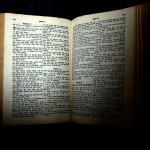The Book of Mormon contains an allegory or two, maybe more than the New Testament, and it presupposes a typological interpretation of the Hebrew Bible. But if my perception is accurate, as a whole we are not very willing to interpret the Book of Mormon other than literally. Which is curious, not because the boundaries between literal and non-literal interpretation are questionable, being tied up with appeals to (objective) history and authorial intent, but because the Book of Mormon itself offers at least one non-literal interpretation of itself. Referring to the Liahona, Alma tells Helaman:
And now, my son, I would that ye should understand that these things are not without a shadow; for as our fathers were slothful to give heed to this compass (now these things were temporal) they did not prosper; even so it is with things which are spiritual. For behold, it is as easy to give heed to the word of Christ, which will point to you a straight course to eternal bliss, as it was for our fathers to give heed to this compass, which would point unto them a straight course to the promised land. And now I say, is there not a type in this thing? For just as surely as this director did bring our fathers, by following its course, to the promised land, shall the words of Christ, if we follow their course, carry us beyond this vale of sorrow into a far better land of promise.
If Alma can read sections of 1 Nephi other than literally, why can’t we do the same? Before getting too carried away, it should be noted that Alma gives no indication of doubt as to the historicity of the Liahona. In fact, he would have had the compass in his possession along with the records and interpreters that he was entrusting to Helaman. That is, for Alma, non-literal interpretation was not necessarily mutually exclusive of literal; literal interpretation need not be threatened by non-literal.
With this in mind, I’d like to issue a friendly challenge. Liken the scriptures to yourselves and do what Alma did. Read the Book of Mormon typologically or allegorically and see what happens. Should you need inspiration, you might consider Middle- and Neo-platonic interpretation of Homer, in which Odysseus is read as the soul, Circe as the danger of reincarnation, the Cyclops as attempted suicide, and the cave of Nymphs as the cosmos in miniature. As Porphyry writes, “when one takes into consideration the ancient wisdom and the vast intelligence of Homer … one cannot reject the idea that he has hinted at images of more divine things in molding his little story.”











